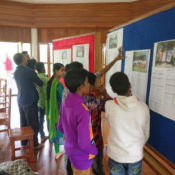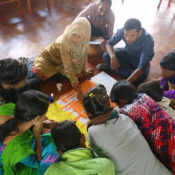Children in Bangladesh Help Researchers Understand Extreme Poverty
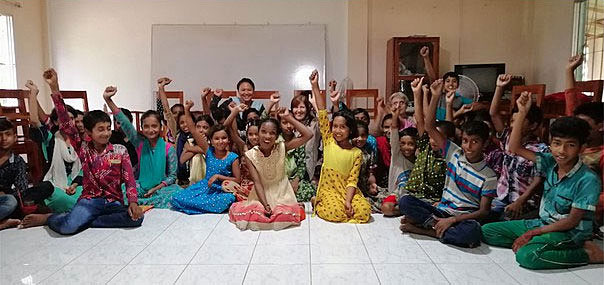
Above: The delegates of various peer groups at the final Tapori Story Workshop.
By Claude Heyberger and Naomi Norberg
“I work in a trouser factory… I don’t get to leave my job at the same time every day. Sometimes I can’t come back home in time because of a traffic jam. That’s why I can’t get to [night] school on time.”
“My older sister did not complete her studies due to lack of money. But she works to help pay for my younger sister to study. My older sister works as a housekeeper.”
These were two facts that children who experience poverty in Bangladesh told researchers. The goal of the project was not just documenting what children said for another gloomy report on child poverty. Instead, the researchers planned to involve the children in analyzing the information collected. The result was not only new information about poverty but also a profound change in the children’s lives.
In order to accomplish this, the researchers had to invent new tools. “What is poverty, really?” they wanted to know. They already knew that poverty is a fundamentally different experience of life. And they knew that it can be transformational when people in poverty have time and space to think through their experiences. But how to engage children in identifying their existential experiences? Could they also analyze fundamental characteristics of lived poverty?
Building trust
Listening to people in poverty is important because they know best what is going on in their lives. Yet people from a background of deep poverty often are afraid to speak openly. For years, others who do not live in poverty have discredited their thoughts and feelings, blaming them for their troubles. This can make people in poverty feel like there is something fundamentally wrong with them.
Because children are painfully aware of how other people often look at their families, the researchers knew they had to work hard to build trust. Fortunately, MATI, a grassroots organization that was part of the research team, had established relationships where some of the work was conducted. Where they did not already have ties, the researchers relied on other grassroots organisations and trusted members of the communities as partners. Some of the researchers themselves came from backgrounds of poverty. This gave them appropriate sensitivity so they could interact positively with the children.
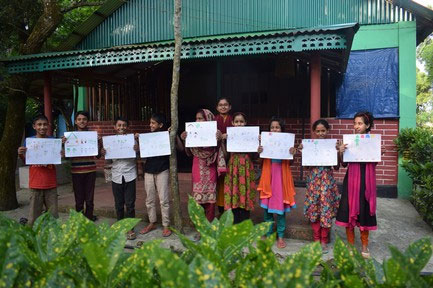
A focus on deep poverty
There is a difference between poverty and extreme poverty, and the researchers were very careful to identify children who did not necessarily stand out as high achievers or leaders. All had experienced deep and long term poverty. Some were child laborers working full time outside the home to support their families. Others lived in a village where their parents worked as agricultural day laborers.
Many of the children experienced cultural discrimination as well. Some lived in a very large Rohingya refugee camp. Others came from a community of Hindu “untouchables” who were long-term residents of an urban slum.
The researchers insisted on going the extra mile to involve children from these particularly challenging circumstances. Before starting the work, the researchers visited each area several times to be sure the community understood and supported the project. In the end, they settled on four groups of boys and girls, all ages 10–14.
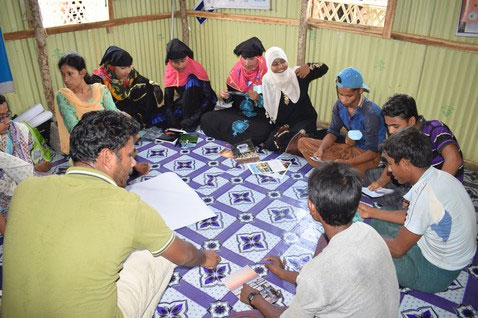
Starting with games, not words
When it comes to asking people in poverty about their experiences, a formal interview is not the best way to listen or hear the truth. This is especially true with children who are easy to influence and accustomed to giving grown-ups the answers they want.
The researchers shared meals to break the ice and help the children feel comfortable with the grown-ups asking them questions. To get the children thinking, the researchers used games and activities such as drawing or pantomime. This took a significant amount of time. Yet it was these specific activities that helped identify the most important elements of the children’s experience. Later, during the analysis phase of the research, some of these elements helped the children see what lay at the root of various problems.
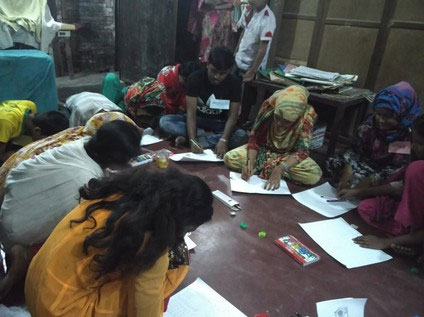
Encouraging openness
The research team didn’t only say, “Everyone’s opinion is valuable” or “There are no wrong answers.” They demonstrated this by recording each child’s statement as equally important. For example, one teenage girl said she felt “mentally traumatized” because she could not afford cosmetics. While this sounded like an exaggeration, the researchers wrote down exactly what she said. Later discussion with her group shed light on what she actually meant by “mental trauma.” This non-judgmental attitude encouraged the children to speak openly and led to deeper understanding of their experiences.
In addition, the research team was careful to take into account cultural factors. Because some girls were shy about speaking out in front of men, the team made sure to have female facilitators on hand. These facilitators spoke the girls’ native language and could interact with them in a reassuring and encouraging manner.
Getting a complete picture
To avoid influencing the children, the researchers invited them to talk about both positive and negative aspects of their lives. In one group exercise, they divided a sheet of poster paper in half. Then they put good things on one side and bad things on the other. This allowed the children to talk about all their experiences in areas like family, school, work, and community.
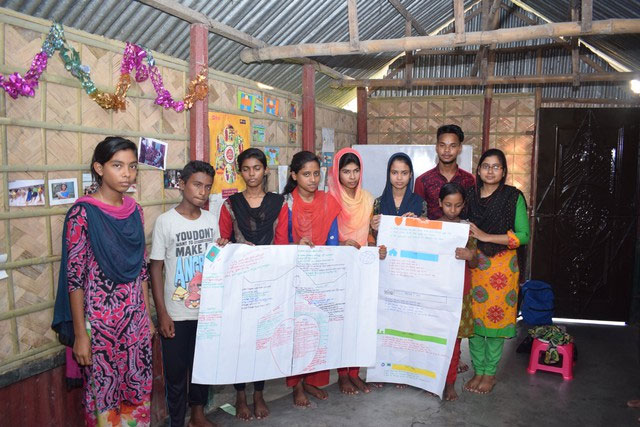
Analysis: from specific elements to abstract characteristics of poverty
The researchers’ goal in Bangladesh was to identify abstract characteristics of poverty. In fact, the work with children there was part of a larger international study with adults in six countries around the world. However, because children are 44% of Bangladesh’s population and many of them live in poverty, the study added a special children’s component in that country.
In the larger study, adults in poverty took part in all steps, from data collection to analysis. The children in Bangladesh had the same opportunity. However, because children are not as accustomed to abstract thinking and analysis, the researchers developed innovative ways to work with them.
Starting with concrete experiences they had described, the children drew pictures of them on cards. Then, working in pairs, the children chose two cards they thought “went together” and presented their pair to the group. The researchers wrote down the children’s explanations of why those elements went together or what they had in common. Then others in the group checked to see if their cards fit in some way with those that had just been presented.
Then the researchers put all the elements the children thought belonged together on one poster, even if there were only two items. In small groups, the children developed a skit to describe what was on the poster. The whole group then discussed the posters to make sure the drawings really did share something in common. Thinking through why certain elements fit together led to naming several characteristics of poverty.
This part of the work generally required two days to get right. It was important to make sure the children really understood the process of abstraction from concrete experiences. For example, the researchers had to explain to the children that they should not put characteristics together just because they were friends.
Grown-ups enter the process
A final step of the research involved ATD’s trademark Merging Knowledge process, also used with adults in the six countries in the international study. Merging Knowledge involves people from different backgrounds working together on equal footing to discuss a variety of perspectives on a particular issue.
With the children in Bangladesh, the Merging Knowledge process took place over two days. Throughout, the children participated as equal partners. Professionals who work with children had already met separately to discuss how to define poverty from their perspective. The session then gathered together elements of the children’s and adults’ understanding of poverty to arrive at a common set of characteristics.
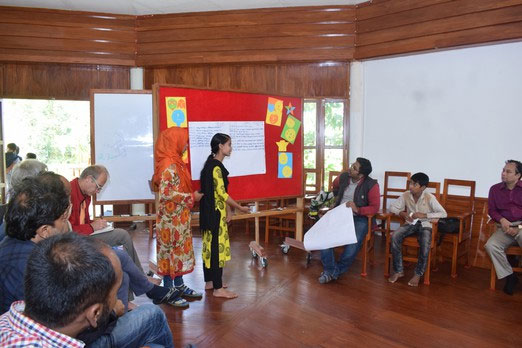
What grown-ups didn’t see
One significant outcome of this process was that the children highlighted an important characteristic of poverty that the adults had not considered: how children contribute to the family’s development and what meaning this has for them. Children often make sacrifices, such as quitting school, for the benefit of their family or community. While these sacrifices can be frustrating, they are also a source of pride that gives children a strong sense of identity.
Follow up and advocacy
After writing the final report for Bangladesh, the research team developed tools to publicize the findings to adults. But the children also were eager to communicate about what they had done and learned together. So MATI partnered with Tapori, ATD’s international children’s network, to organize a post-research workshop. The children wrote four stories they could use to talk about the characteristics of poverty they had identified.
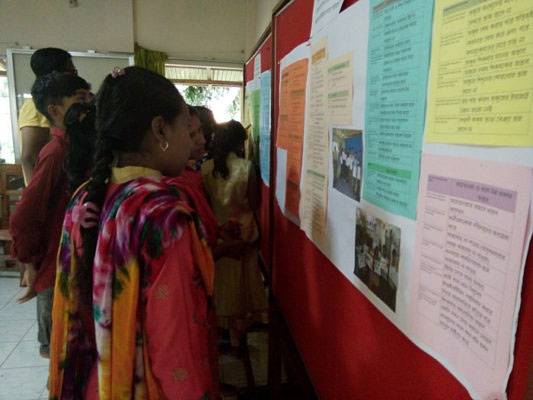
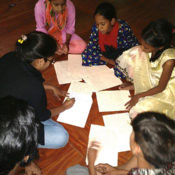
These stories will become part of the “Children of Courage” Tapori Minibook series. In this way, the Bangladesh research project became part of ATD’s broader work to empower children and to encourage them to hold on to their dreams for a better world.
This article is adapted from a longer version found here.
To learn more contact and .
The MATI report on this project is here.


